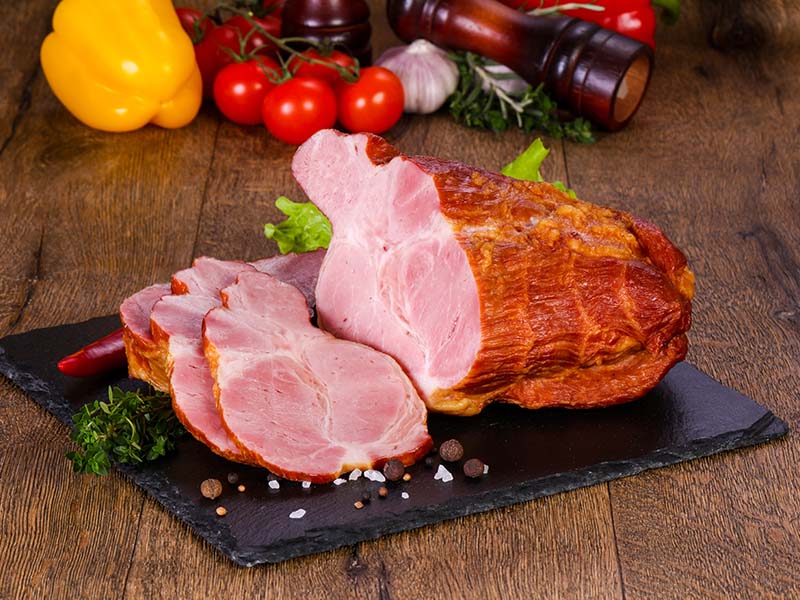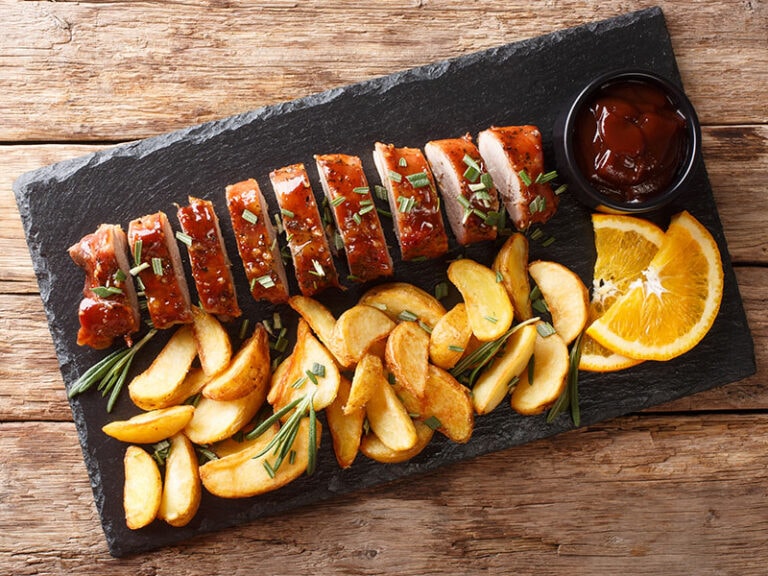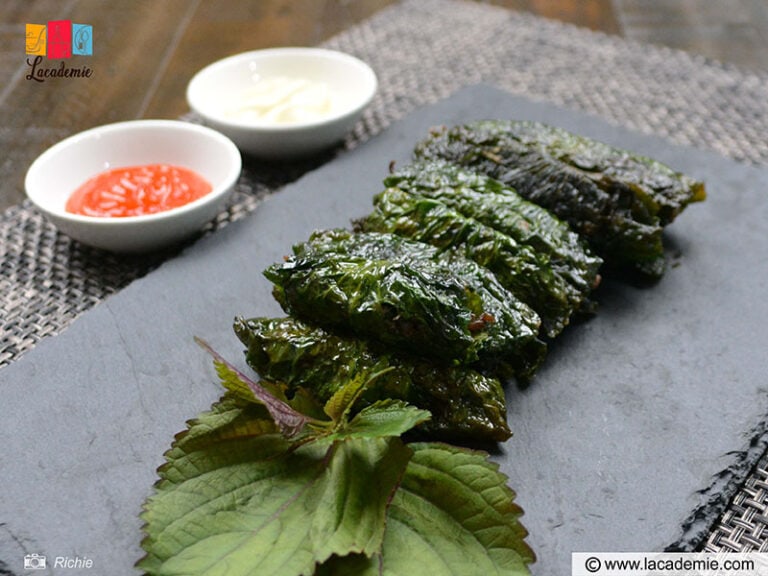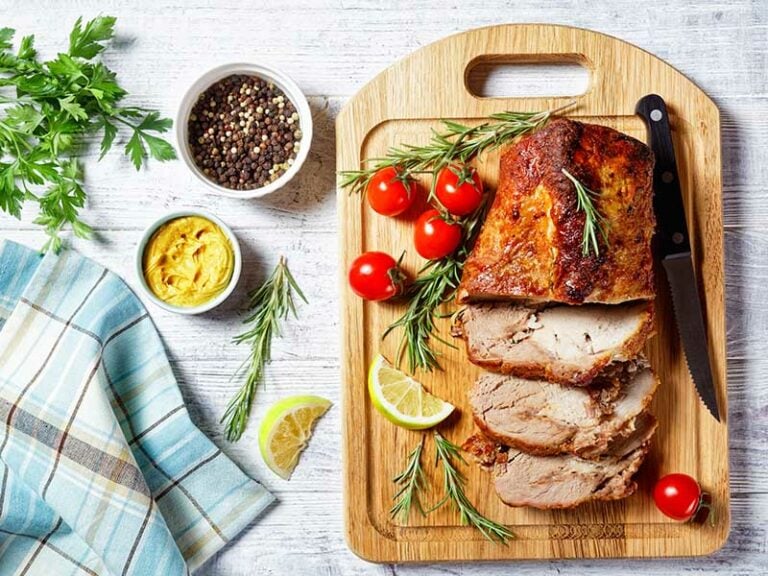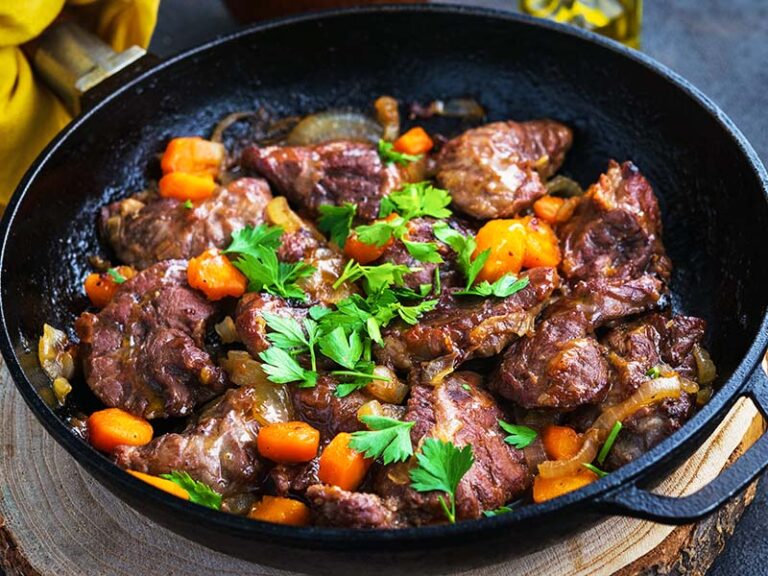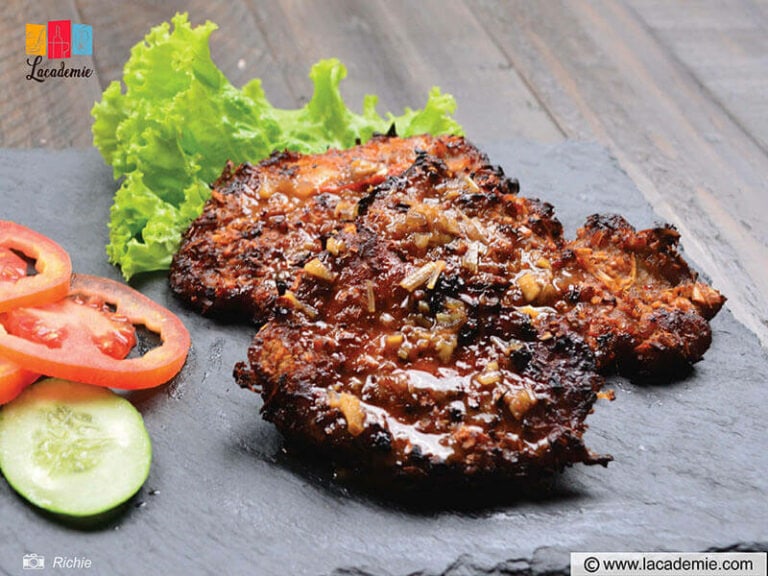How long does it take to smoke pork shoulder at 225°F? Smoking requires a lot of patience. You can not see the result in an hour or two. But with a piece of pork shoulder, how much time will it take to have a nice smoked flavor at 225°F?
People often compare pork shoulder with pork butt or other cuts. But regarding smoking, it is many chefs’ favorite choice. Slow cooking helps the pork shoulder collagen turn into gelatin, producing juicy and tender smoked meat.
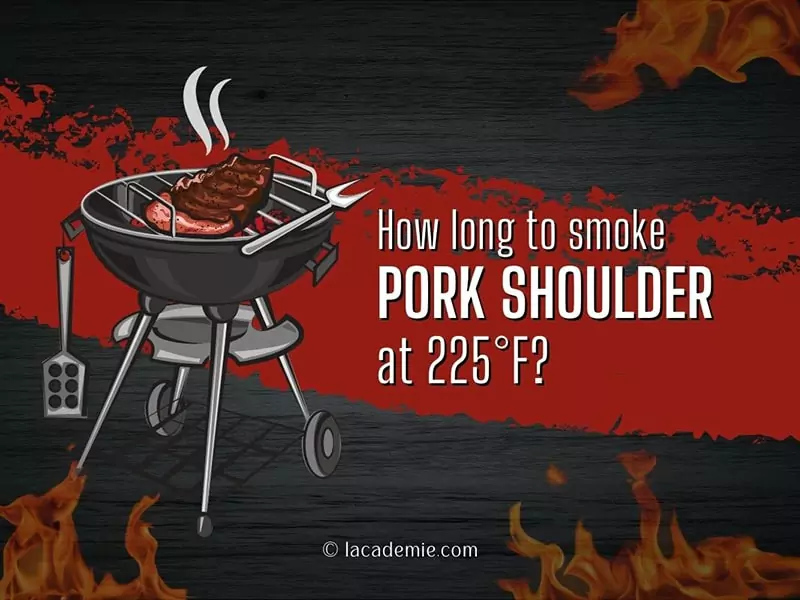
Nutrition Facts of Smoked Pork Shoulder
Speaking of the pork shoulder, we can not forget to talk about its full-packed vitamins and proteins. What’s more, I also will address the importance of 225°F in smoking pork shoulder below.
Nutrition Facts
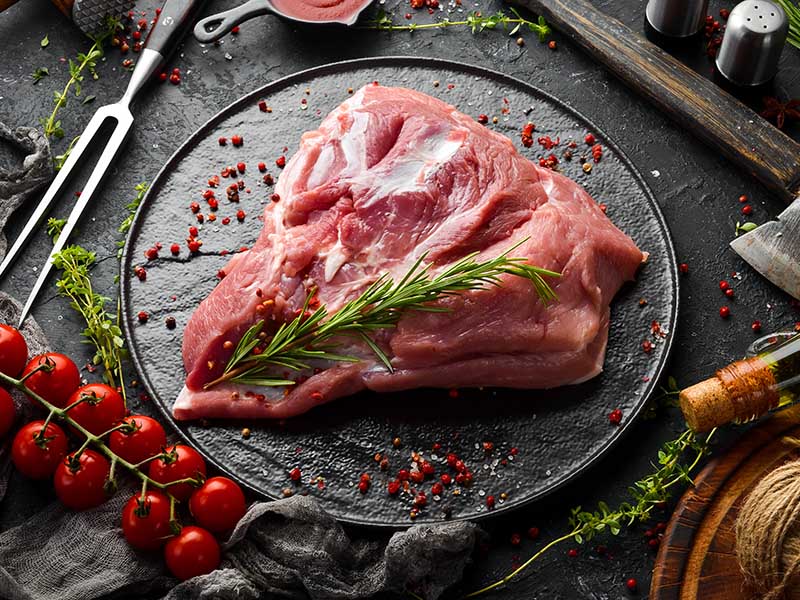
The pork shoulder lies above the pig’s left leg. The nutritional value of pork should depend on the meat’s cut. Though many people confuse pork shoulder with pork butt and vice versa, there are many differences between those two cuts.
A 100-gram serving of fresh pork shoulder contains 186 calories, with 60 percent of them from fat and 40 percent protein. Plus, the pork shoulder is also rich in fat, especially saturated fat. Every 100-gram portion has 18 grams of fat and 6 grams of saturated fat. (1)
On the other hand, pork is famous for being rich in animal protein, especially when pork shoulder contains up to 17,2 grams of protein per 100 grams of meat.
Pork shoulder also contains many amino acids, which help provide energy to the body, make proteins for muscle growth and maintain brain function. (2)
At the same time, pork shoulder is an ample source of vitamins B, niacin, B6, and vitamin B12 which are vital to form blood cells and improve brain function.
Discover why people need saturated fats (which pork shoulder has) and what their functions are.
Why 225°F Is The Perfect Temperature For Smoking Pork Shoulder?
You may ask why 225°F is the ideal temperature to smoke pork shoulder, and it’s a pleasure of mine to give you an appropriate answer.
As you know, smoking is not about the time but the temperature. Compared to other familiar types of cooking methods, smoking takes a longer time to get the food done. What matters is the quality of your smoker/grill, which greatly influences on the temperature.
The standard temperature for low and slow smoking falls between 225°F and 250°F, sometimes 275, based on how large the meat is and how tender you want to leave the pork be.
If you go lower than 225°F, according to USDA, the meat will be in a “danger zone” for microbial growth. On the contrary, the moisture will escape if you cook it at a higher temperature.
In my opinion, 225°F is the perfect temperature to smoke an average large pork shoulder from 5 to 10 pounds. Over time, the exterior will have an amazing dark bark while the collagen will break down, resulting in the interior being juicy and tender enough to shred with a fork.
Bear in mind the temperature if you want to make smoked pork shoulder next time.
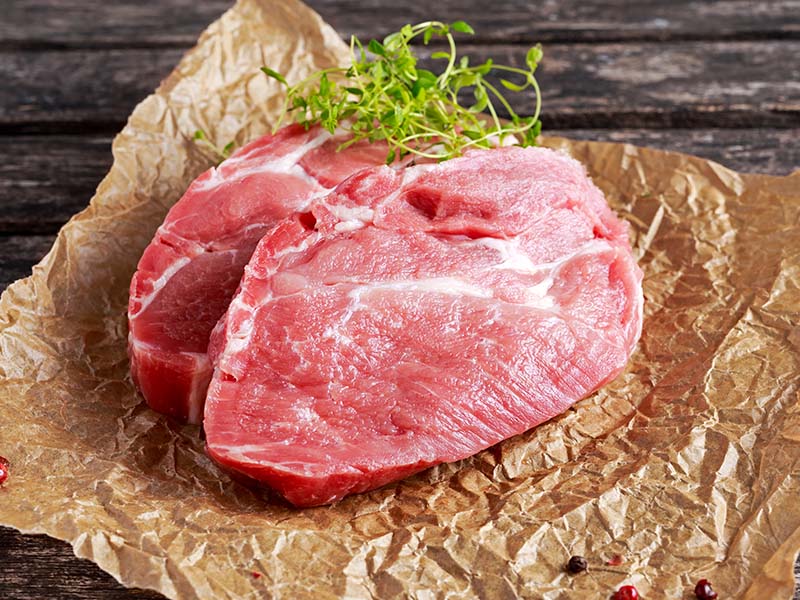
How Long To Smoke Pork Shoulder at 225°F?
As you know, 225°F is the ideal temperature for slow and low smoking. Technically, the temperature will affect the cooking time. The key here is going low and slow.
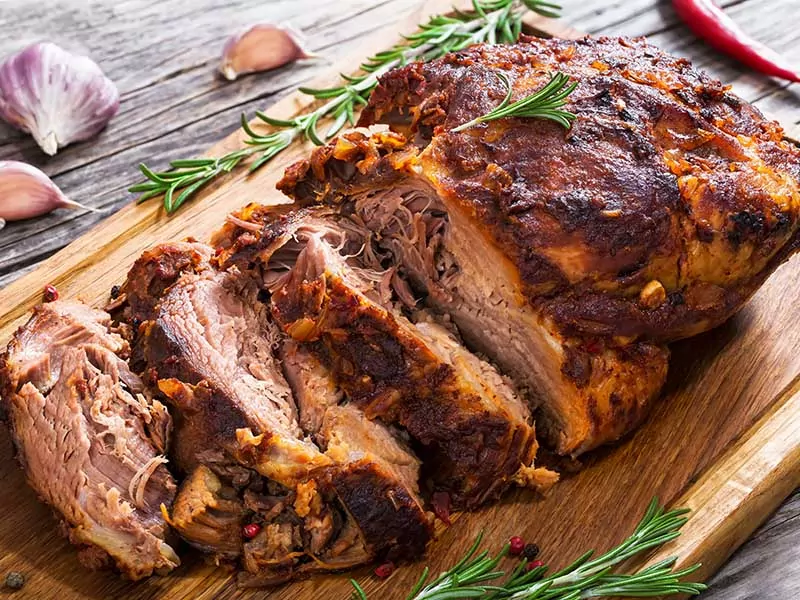
Average Time to Smoke A Pork Shoulder
I have to say smoking pork shoulder is a pretty forgiving process. The time of cooking fluctuates according to the pork weight.
Why do you have to ‘low and slow’ smoke pork shoulder? Due to being the heavily-worked muscle of the pig, the protein fibers of the pork shoulder are tough. So it takes time and effort to tenderize it.
When your smoker/grill is set at 225°F , the pork shoulder is expected to be cooked at a rate of 60 to roughly 120 minutes per pound before it’s done.
However, don’t count on a timer because so many factors can go into a piece of meat taking longer cooking times, including smoker variations, the outdoor temperatures and humidity, and more.
For example, at 225°F, a 6-pound piece of pork shoulder will take 8 to 9 hours. And you will need 12 to 16 hours for a larger 10-pound, bone-in pork shoulder.
How Long Does It Take To Reheat A Smoked Pork Shoulder?
As smoking takes such a long time, if you are too busy, you can make the pork the day before.
First, smoke the pork shoulders as usual, and let them rest. Then shred the meat (preferably with a fork) and let it cool completely. Next, add the pork to foil pans and keep the pork wrapped in the foil package in the refrigerator.
Keep the foil package in that state overnight. When you want to eat the pork shoulders, reheat the smoker or set an oven to 225°F. Wait 40 to 45 minutes and remove the cooked pork.
Learn everything you need to know about shredding the meat with a professional chef.
Saving Time with Foil
If you are in a time crunch, I suggest wrapping to speed up the cooking time. Set aside the time, wrap the pork shoulder in foil or butcher, and smoke it at 225°F. During this period, the heat gets trapped inside the wrapped fork and cuts short the process.
In return, pork wrapped in foil will lose the smoke flavor. An unwrapped pork shoulder will take a longer time but will develop a richer bark and caramelized exterior.
However, you can over-smoke an unwrapped pork shoulder if you leave it in the smoker for too long. After 5 hours in the smoker, the smoke has penetrated deeply into the meat. At this rate, any more smoke will add layers on top of the bark and lead to a bitter taste.
How to Smoke Pork Shoulder at 225°F?
A smoker is not the only equipment you can use to smoke pork shoulder. Other options include a gas grill and charcoal grill. Don’t be afraid to try on new methods. The keys are your skill and patience to bring the best results.
If you are ready to buy any grills or smokers, you can learn more about the BBQ equipment here.
Smoker
In my opinion, using the smoker is the easiest way to smoke pork shoulder. I highly recommend beginners use this method.
Step 1: Prepare The Smoker
First thing first, read the smoker’s manual to get your tools ready at best. Fill a baking dish or foil pan with water to keep the pork moist afterward.
Step 2: Take Care of Your Pork
Remove the pork from the package and pat it dry with paper towels. Rub the exterior with yellow mustard or olive oil. Season your pork shoulder and rub the meat on all sides.
Step 3: Turn on The Smoker
Preheat your smoker to 225°F for indirect smoking. Add your seasoned pork to the smoker grate. You should place it in the middle to avoid any hot spots.
Insert a meat thermometer and check the pork shoulder if it reaches at least 195°F. The process may take more than 15 hours, so just take your time.
Step 4: Let It Rest
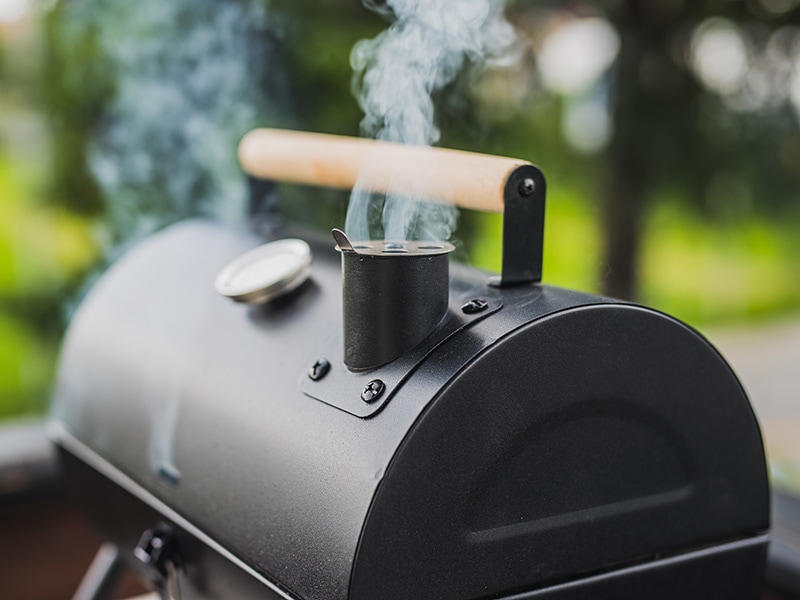
If the pork shoulder has an internal temperature of between 195-205, take the meat out and wrap it in foil while it rests for 20 minutes or up to 2 hours.
Charcoal Grill
The vent is crucial to smoking pork shoulder with a charcoal grill. It will regulate the temperature inside the grill during the whole process. Opening the vent will allow the airflow through the grill and keep the charcoal hot.
In particular, fire needs oxygen to burn. Therefore, the vent will play the role of a window of the charcoal grill. If you open the vent, you allow more oxygen to get in. The more oxygen there is, the more heat the charcoal grill gets.
Uncover some tips for smoking pork shoulder on charcoal grills with this guide.
Step 1: Rub The Pork
Take the rub on your pork shoulder with the seasoning. Get full coverage on both the back and the front. It’s up to you how long before you want to prepare the meat.
Place the mustard to seal in the dry rub and inject the pork with a mixture of apple cider, vinegar, and apple juice to tenderize the meat.
Step 2: Load The Charcoal
Let’s get started with adding charcoal to the chimney. Burn either a leaf, newspaper, or paper for kindling. Now let the fire roar. Remember that smoking is a long process so you have to be patient.
Let your charcoal burn for about 15 to 20 minutes. And once the coals are covered with gray ash, pour the hot charcoal on one side of the grill.
You will divide the charcoal grill in a ratio of 60 – 40, which means 40% of charcoal and 60% empty space, to place the dripping pans. Pour the liquid (apple juices) into the dripping pans and put the grill grate on
Put the wood chips in an aluminum patch and make holes on the pouch to let the smoke come out. Then place the pouch on top of the charcoal.
Step 3: Let’s Get Things Done
Put the pork shoulder on the non-charcoal side. After a few minutes, the pouch of wood chips will start smoking. You now can place the lid back and have the air vent open a quarter of the way.
Remember that the more you open it, the higher the temperature is, and vice versa. Then place your thermometer. The goal is to reach 225°F.
After 4 to 6 hours, when the internal temperature reaches 160°F, flip the pork shoulder and spray it with the half-and-half mixture (half apple cider vinegar and half apple juices) every hour. The wood chips will stop smoking after a few hours, so you can add another pouch.
Step 4: Don’t Forget to Let The Meat Rest
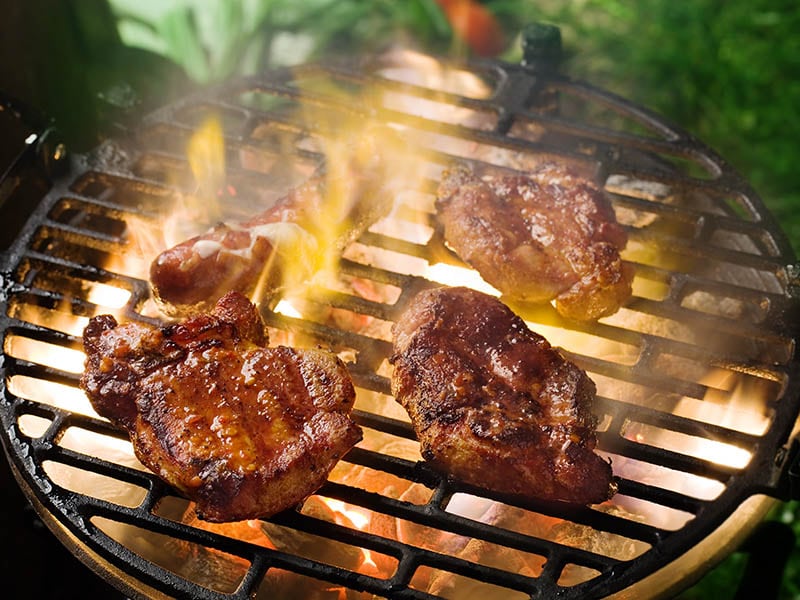
In the last hour, probe your meat to test. When the pork has reached your desired temp, remove the pork shoulder from the grill and let it rest from 30 minutes to 1 hour or so.
Gas Grill
Smoking pork shoulder with a gas grill will require more preparation and effort during the process.
Step 1: Give The Pork A Rub
Apply salt or your own seasonings to all sides of the meat and refrigerate it overnight. An hour or two before starting to cook, take the seasoned pork out of the refrigerator and leave it at the room temperature.
Step 2: Prepare The Grill
Get your gas turned on and get your grill fired up. With the gas grill, you will run indirect heat. Remove one of the burners to leave enough room for the pork shoulder.
Now you will need some wood chips or pellets and put them in a smoker tube. Add a little bit of lighter fluid on the top to get the grill started. Then set the burner on the lowest setting and add the smoke tube to the front of the grill.
Step 3: Let The Fire Start
Turn the grill on medium flame. As you can see, some great smoke starts rolling. It’s time to drop the seasoned pork shoulder right in the indirect heat spot. On the opposing corner, place a bowl of water.
Now, you will see plenty of smoke coming out on the back of the grill. Each hour, open the grill and spritz a mix of cider vinegar on your pork. Try to maintain the temperature at 225°F.
If not, keep it close to that number, varying from 210°F to 240°F. Just enough to keep the meat moist and tender.
After a few hours, your smoke tube will eventually run out of smoke. Remove it and replenish more wood chips, and add it back to the grill.
Step 4: Test The Internal Temperature
Use a wireless thermometer for meat to check the internal temperature of the pork. Remember to avoid the bone when inserting it. Try not to open the grill too many times because it will affect the inside temperature and prolong the cooking time.
Pull the thermometer out once it reads your target temp. You can eat it at 160°F, but the ideal done pork temp should be at 195°F.
Step 5: Get The Meat Out and Let It Rest
Once the temperature reaches 195°F, remove the smoke tube and lift your pork shoulder out of the grill. Wrap the meat in foil. Be gentle and careful if you don’t want the juice from the roast to escape. Let the meat stay still for at least 30 minutes or more.
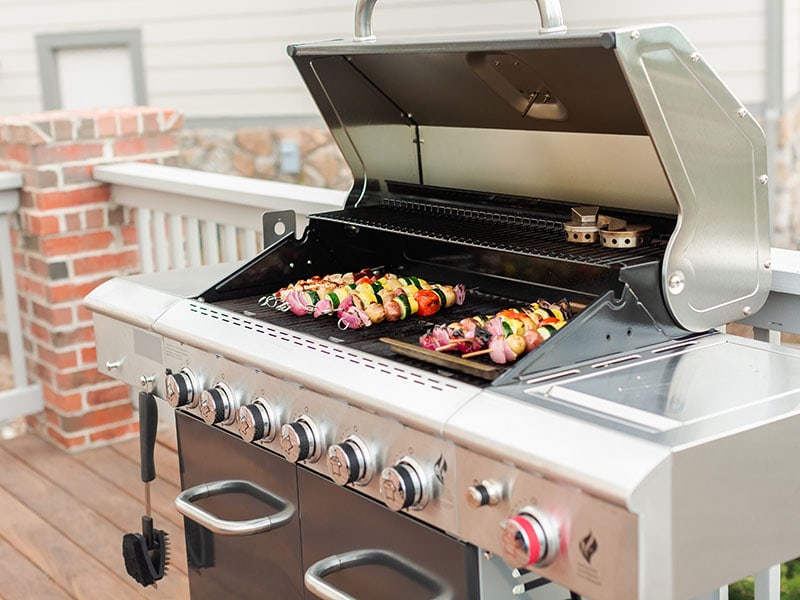
What Are The Differences Between Smoking Pork Shoulders At 225°F And 250°F?
Each temperature has different drawbacks and benefits and requires different approaches in the cooking process. Actually, it’s your personal choice to choose whether your meat should be cooked at 225°F or 250°F.
Let’s Take A Look At Pros and Cons of 225°F
You can achieve a good result by smoking pork shoulder at 225°F. As I said before, 225°F is the ideal temperature for this way of cooking. Moreover, you will save a bunch of fuel during the process.
Plus, it is easier to manage the fire pit with a longer time and lower temperature. If you are new to the BBQ work, 225°F or low temperature is a better start. Lower temperature and slower pace will ensure your pork is palatable and safe.
On the contrary, smoking pork shoulder at 225°F requires a longer time and patience. And the risks you have to face are that the meat may not be undercooked or fail to break down all the fat, collagen, and connective tissues within the pork.
Normally, 220°F – 225°F may render some of the soft fat, but there’s a chance that you won’t get the delicious top layer of salty fat. Sometimes, waiting a long time leads to impatience. You tend to pull the pork out too soon, resulting in an underdone pork shoulder.
Smoking at 250°F – Why and Why Not?
At 250°F, your pork shoulder will be soft and juicy because of a higher temperature. I can’t deny the fact that cooking at a high temperature will save a lot of time while still bringing a great result.
Compared to 225°F, the smoking time of a pork shoulder may vary from 75 to 90 minutes per pound.
Moreover, smoking pork shoulder at 250°F will render down all the connective tissues and fat. At high temperatures, it seems that the collagen, connective tissue, and fat respond better than the 225°F mark.
In other words, smoking at 250°F will make sure to break down and soften the fiber without going so hot that it almost grills it.
On the other hand, smoking at a higher temperature requires more fuel to ensure the fire’s consistency. After all, smoking is all about good temperature control. You already know that it’s not easy to keep the fire stoked to hit 250°F.
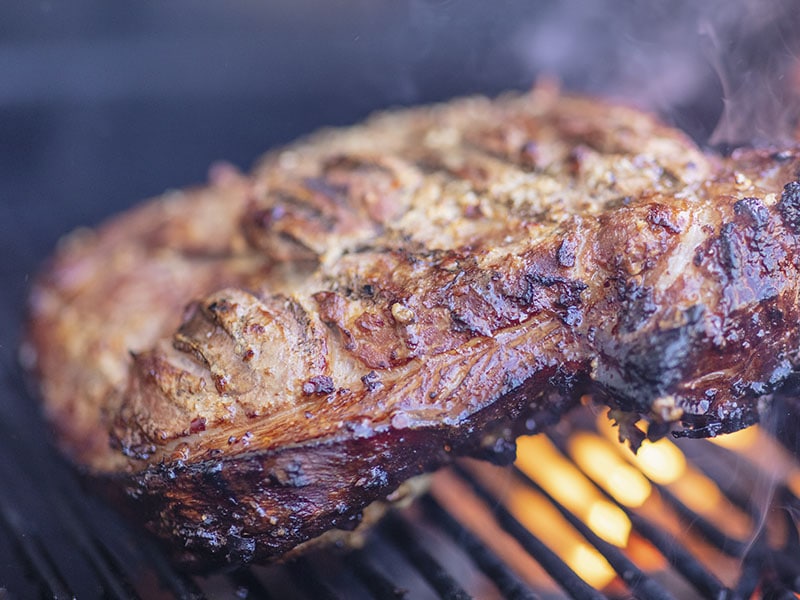
How To Tell Your Smoked Pork Shoulder Is Done?
Although a thermometer is the best tool to test the temperature of the meat, we can use other methods to estimate the doneness of your pork in case you don’t have one.
What Temperature Is Smoked Pork Done?
Because of the ‘low and slow’ way of smoking, the pork shoulder would be in the smoker for a long time. So you don’t have to worry about the inside being undercooked or not. But again, if you want to make sure, a meat thermometer should be the tool that you use in this case.
Specifically, the pork’s internal temperature should be at 195-205°F. And when inserting your thermometer, if it can be pulled apart easily, you know the process is coming to an end.
Technically, it’s safe to eat pork when the meat’s internal temperatures hit 165°F. But the degree of tenderness will vary at this temperature depending on the meat cuts.
You will probably get a chewy smoked pork shoulder at 165°F. Why? Because pork shoulder has a lot of connective tissues, it takes more time to tenderize.
Nevertheless, the pork will be more tender and juicier if you give it an hour of rest. When removing the meat from the smoker, wrap it in the foil and wait for an hour. Doing so will help the pork to reabsorb the juices.
Check The Internal Pork’s Temperature With A Thermometer.
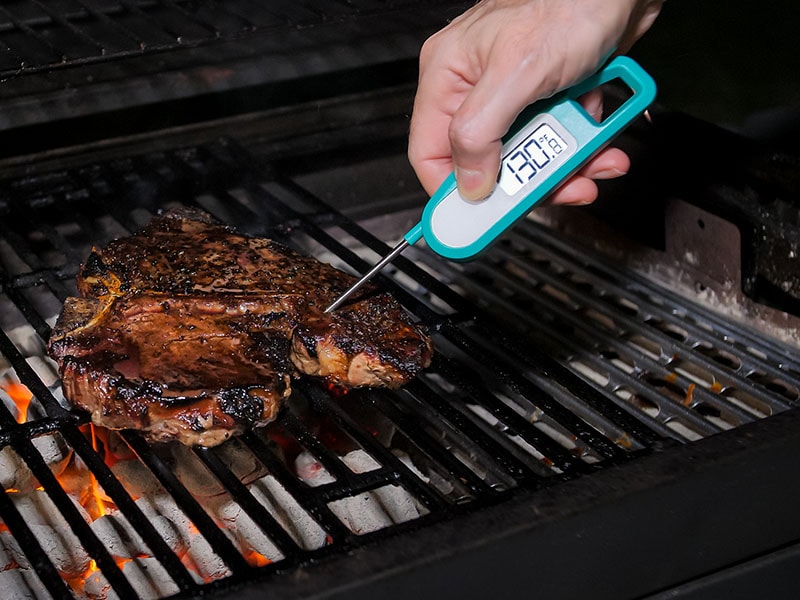
Generally, for a successfully smoked pork shoulder, a meat thermometer has a vital role besides the smoker (of course). Well, you have to keep an eye on the internal temperature of both the meat and the smoker.
Insert your thermometer into the center of the thickest part of the pork to track the internal temperature. Yet make sure to place the thermometer at least an inch away from the bone.
The smoked pork shoulder is ready once it reaches about 200°F. Some pitmasters advise to take it from the smoker at 195°F, but I prefer waiting until the thermometer reads 203°F.
You can learn how to use a thermometer here. Now, you will get a reliable sidekick in your kitchen!
Check The Internal Pork’s Doneness Without a Thermometer
Using a thermometer is not the only way to check the pork’s internal temperature. I will give you 2 more options.
Pull The Bone Out
When the smoked pork shoulder is done, it will develop a beautiful wobble. A properly smoked pork shoulder will wobble (it will move from side to side when you touch the meat) as the connective tissue (collagen) has dissolved to gelatin.
As the collagen breaks down, the bone can be pulled out nice and clean. The perfect tenderness of your pork will be a built-in thermometer.
Give the bone a wiggle at the end of the cooking process. If you can pull the bone out with ease, your pork is ready to come off.
Poke It
Prepare a fork, butter knife, or whatever can probe through the meat on your hands. Stick it into the meat and move it from side to side. If it goes in and out with no effort, your pork is ready to serve. Check a couple of parts of the pork to make sure.
Hit-or-miss Way
You can check the pork doneness by cutting it and observing visual clues. If the meat juice looks clean and clear, your smoked pork shoulder is done. If not, your meat still needs more time in the smoker.
Here Come Things You Should Notice When Smoking Pork Shoulder
A lot of factors will affect your cooking time. Some are natural, and some are not. At least, pay attention to these things to avoid a fork in the road. There is no doubt that grasping your circumstances will reduce a lot of stress.
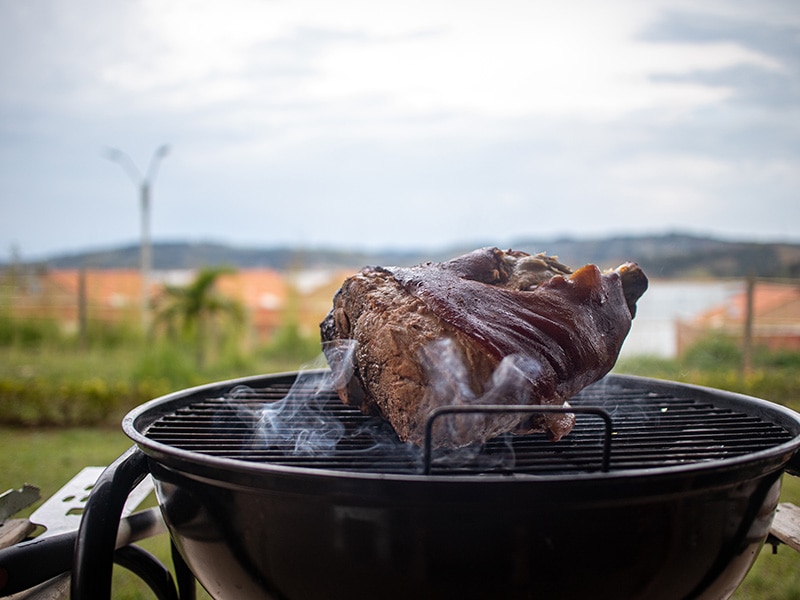
These Factors Are in Your Hands
Nature can easily interfere with your smoking some pork shoulders. But aside from the natural elements, you can still get some other factors under control when smoking your pork shoulder.
Selecting A Smoker
Put simply, different types of smokers will come up with different results. Among many factors that are out of your hands, this one is your personal choice.
Smokers are diverse in types, prices, and uses. But in general, you need to notice a few factors when taking a new machine home, such as the space you have, the fuels, and your budget.
Just by analyzing the above factors reasonably, you can choose a suitable smoker. For example, electric smokers produce faster cooking times than the original ones. However, the flavor won’t be the same as the one made from the burner or charcoal smoker.
Controlling The Internal Temperature
Even though the smoker’s internal temperature will be affected by many external factors, you can still own it with the right tools and patience. The trick here is to monitor the cooking temperature.
First thing first, a thermometer is a necessity. You will use the thermometer throughout the entire process, so make sure you buy a good quality one.
A high temperature will tighten and dry out your pork. So another tip is to use a pan of water to stabilize the heat and add moisture. When your pork is in the charcoal for more than an hour, you need to add more humidity to it.
Things That You Don’t Want to Happen
Many external factors add obstacles to your cooking process. So always remember to be prepared when dealing with unexpected situations. Maybe you are not that unfortunate, but I hope you come prepared.
Wind Speed
When it comes to cooking outdoors, the wind is your enemy. Sometimes it is harder to deal with than the rain. But nothing is impossible; you can still smoke pork shoulder in the wind.
As long as you pay attention to the smoker, the flame, and the direct flow of the wind, you will be fine. No matter what smoker you are using, try to keep the temperature as consistent as possible. If needed, put the smoker in a shielded area to protect it from the strong wind.
Smoking against the wind is frustrating, but you can be the winner in this battle.
Outdoor Temperatures
Now, let’s talk about another troublemaker in the bbq world: the outdoor temperature. The gap between the outdoor temperature and the smoker’s internal temp affects a lot on the final result.
On warm days, you can easily control the smoker’s internal temperature and the warm weather also helps the fire get hotter and more consistent.
Regarding cold weather, you have to prepare more fuel to maintain the proper temperature for your pork if the outdoor temperature drops more drastically than the smoker. Not to mention, the cold weather will bring its friends like harsh winds, snow, or rain.
Tips And Tricks to Bring A Kick of Flavor
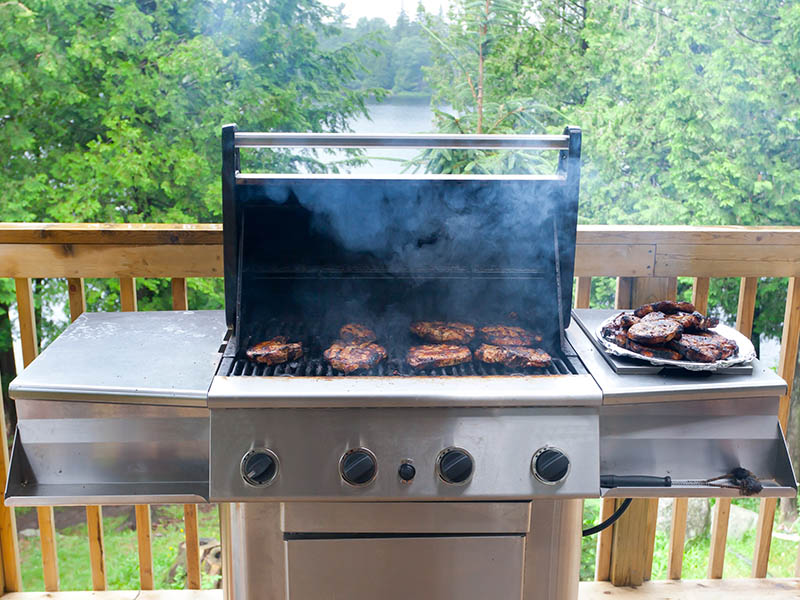
Everyone knows the importance of pork quality and temperature when smoking, so I’ll give you a few more tips and tricks for a delicious finish.
- Pay close attention to the thermometer to keep the temperature consistent.
- Remember to add moisture to the pork during cooking unless you want dried meat at the end.
- You can choose to wrap your pork or not. Wrapping your pork will speed up the cooking time, but the flavor won’t be the same.
- Add variations to spice up the flavor, such as BBQ sauce or mustard.
- Replace sugar with other substitutes if you are on a low-carb diet.
- Avoid using pork that has been frozen for too long. Red meat is always the best choice.
- If you wrap the pork, be sure to save the juice. You can mix it with the meat later.
Tasty And Easy Smoked Pork Shoulder Recipes To Expand Your Menu
One thing that I know for sure is that theories and practices have to go hand in hand. Everything has to go through trial and error. Now let’s roll up your sleeves and get the meat done with these smoked pork shoulder recipes.
Basic Smoked Pork Shoulder
This recipe can be viewed as a simple step-by-step tutorial for beginners in the barbeque world. With this recipe, you can use any type of smoker. Smoked pulled pork can be kept in the refrigerator for up to 4 days. And if frozen, the meat will last for up to 6 months or so.
This is among the most straightforward smoker recipes that you can follow. Plus, it will give you a perfect mix for a great rub and a flavor injection.
Carolina Style Pulled Pork
If you have done the smoked pork shoulder several times before and want to add some styles to the dish, then give this Carolina pulled pork version a try. This recipe is widely used in western North Carolina.
It’s worth noting that this Carolina-style recipe will use ketchup and brown sugar to add a little kiss of sweetness. However, feel free to omit the additionals if they are a little dramatic for your taste.
Who wants a bite of this Carolina pulled pork? Here is the instruction.
Cider Brined Pulled Pork
The special thing about this recipe is that you will add a step of brining the pork shoulder in preparation. Don’t forget to buy a meat injector!
After coating in the brine ingredients, the pork will be refrigerated for about 8 to 12 hours. Before smoking, dry the meat with paper towels and keep the brine liquid. Then use the meat injector to inject the remaining brine liquid directly into the pork.
Thanks to this step, the meat will be marinated from the inside-out. Then you can start other steps as usual.
FAQs
I will add some more side questions here. I hope they will help you get some more insight into our favorite smoked pork shoulder.
If You Finish Reading This Manual, You Are Fully Prepared
Honesty, I really think you could be a pitmaster after reading my article. I always consider cooking to be a science, and smoking will teach you a lot about patience. You can try and fail, but don’t give up. A delicious, savory smoked pork shoulder awaits you.
Now, if you find this article helpful, share it with your friends. Also, I would love to hear your thoughts, so don’t forget to leave a comment below.
Nutrition Facts
16 servings per container
- Amount Per ServingCalories679
- % Daily Value *
- Total Fat
48.8g
74%
- Saturated Fat 17.9g 85%
- Cholesterol 204mg 68%
- Sodium 1072mg 45%
- Potassium 784mg 23%
- Total Carbohydrate
3.8g
1%
- Dietary Fiber 0.6g 0%
- Sugars 2.5g
- Protein 53.2g 106%
- Calcium 65%
- Iron 3%
* The % Daily Value tells you how much a nutrient in a serving of food contributes to a daily diet. 2,000 calories a day is used for general nutrition advice.
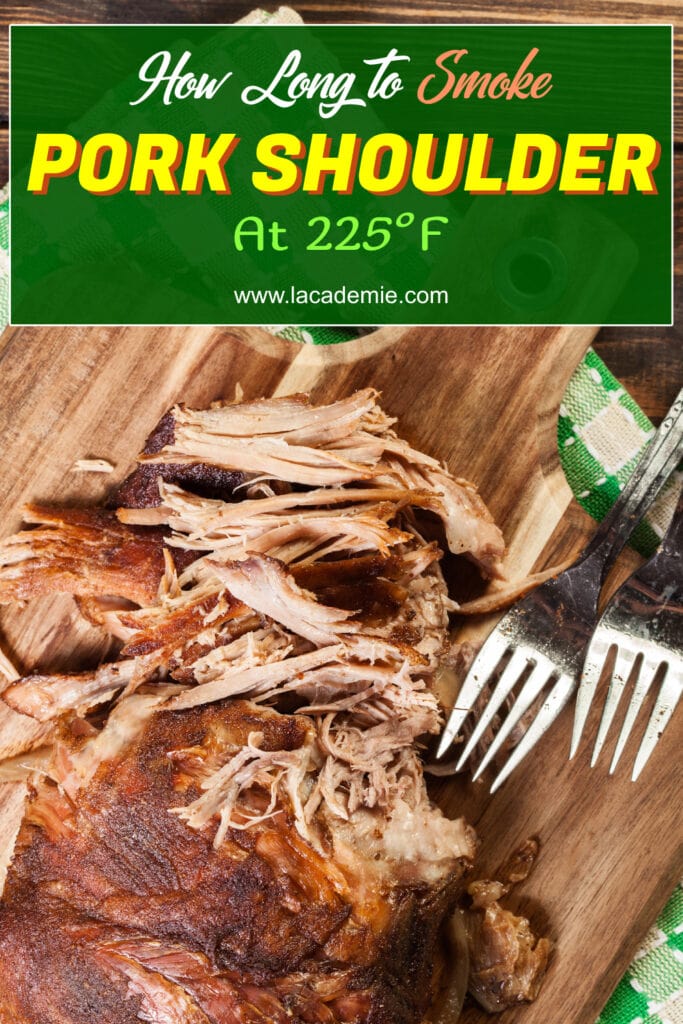
References
- fdc.nal.usda.gov. 2022. Pork, fresh, shoulder, whole, separable lean and fat, raw.
- Encyclopedia, M. and acids, A., 2022. Amino acids: MedlinePlus Medical Encyclopedia.

